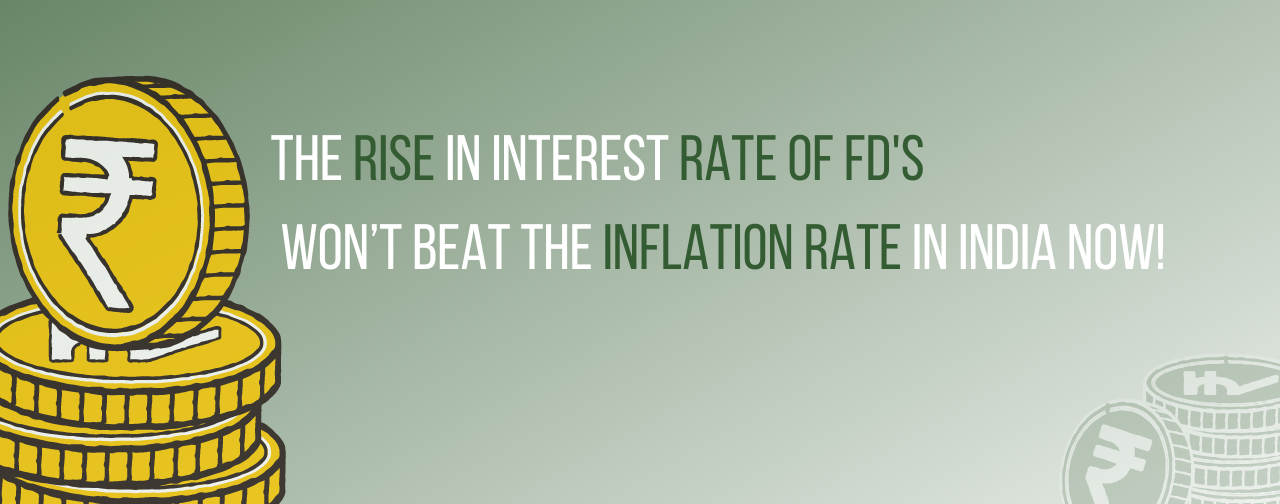The rise in interest FD’s rate won’t beat the inflation rate in India now!
The inflation rate of India in May was 7.04%. Well if you ask about April it was 7.79% which was 8 years high. It has resulted in an increase in the prices of food, especially vegetables (18.26%), oils (13%), spices (10%), and so on. The pressure of this was not only on food but also on transportation, clothing, communication, and many other important sectors.
I am focusing on the above facts because there are certain things I would like to address when it comes to beating the current inflation rate in India. Working as a Certified Financial Planner gave me the privilege to work with various age categories of clients. Where 20 to 35 can be a new bee to investments, 30 to 55 a responsible family member to 55+ who has more experience and have seen the world. There are a few common things in all the 3 age groups i.e they have some scalable financial goals, they want to beat inflation and they require the financial product to beat the inflation. I have various investment avenues to suggest but the real challenge starts when we question our few clients about their investment in traditional FDs. It is imperative for us as financial planners to make our clients understand the process to break the myth that FDs can beat the inflation rate.
Here I am not saying that FDs won’t help you to meet your financial goals, as it was one of the most preferred investment avenues in the ’90s and many of my clients have experienced the benefit of it. But Change is the only thing that is constant in the Universe!!
Hence with respect to that, we need to gauge the fact and ask ourselves do FDs will help us to beat inflation now?
Let’s understand with a simple example that explains the cost of the inflation rate
The cost of milk in the year 2011 was around 25 Rs per litre and now in 2022, it’s around 50 Rs per litre. Well, that’s inflation. We are paying more for the same quantity of milk as and when the time is surpassing and this is how it affects our pockets. This is only one side of the story. It affects your traditional FDs too.
To understand how it affects the traditional FDs we need to dive into the Factors of Inflation-
Demand & supply
To decrease the money supply in the market, the government increases the FD’s rate of interest. People find it lucrative to invest as it is safe and it has an increased interest rate. However, the short-term FD rate might look lucrative but it won’t help us in the long term when we are competing with inflation. When we talk about using FDs to achieve our financial goals, we need to see the fact that FDs are eating away at our purchasing power.
The attention is on the current inflation rate which is growing by 7.43% and the most invested product is a traditional FD. The yield is not even 7% in the time horizon of 1 to 2 years. So here one should question, will your traditional investment plans suffice the long-term investment goals?
The motivation behind my writing this blog is I have seen a constant feed on social media about retail inflation and the rising interest rates. Well, I would like to tell you there is a correlation between each other. It’s a normal practice for RBI to raise the interest rate in order to keep up the economic growth when inflation is high. Unfortunately with that Home loans also get costlier. We fail to realize that our lifestyle inflation is 1 to 1.15% more than the RBI inflation rate.
So for more clarity check the examples of Inflation and FD’s interest rates below.
Inflation |
FD |
||||
| Effective Date | Inflation Rate | Effective Date | Interest Rate (%) Avg. | ||
| 2009 | 10.88% | 2009 | 7.00 | ||
| 2010 | 11.99% | 2010 | 6.41 | ||
| 2011 | 8.86% | 2011 | 8.35 | ||
| 2012 | 9.31% | 2012 | 8.66 | ||
| 2013 | 11.06% | 2013 | 5.916 | ||
| 2014 | 6.65% | 2014 | 8.79 | ||
| 2015 | 4.91% | 2015 | 7.79 | ||
| 2016 | 4.95% | 2016 | 7.08 | ||
| 2017 | 3.33% | 2017 | 6.70 | ||
| 2018 | 3.95% | 2018 | 6.55 | ||
| 2019 | 3.72% | 2019 | 6.60 | ||
| 2020 | 6.62% | 2020 | 5.62 | ||
The above data shows how year on year the inflation rates are rising above the provided interest on FDs.
I would like to conclude by saying that no investment avenue is bad, it’s about your financial goals, your time horizon, and your risk appetite. Even that can be easily sorted once you sit with your financial planner. If you have any questions, you can email us, I will be happy to answer them.
